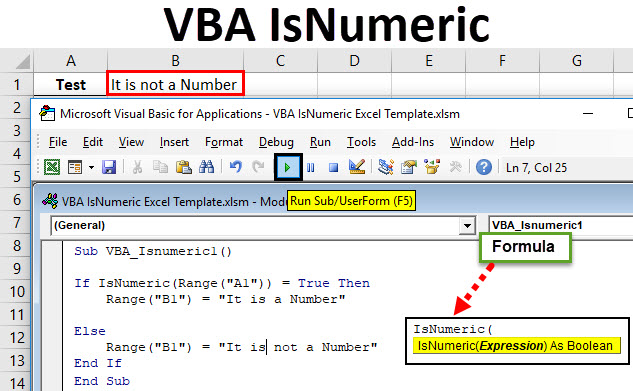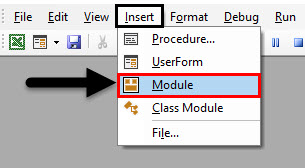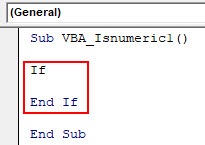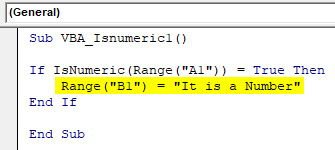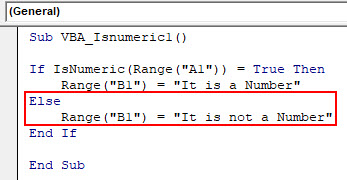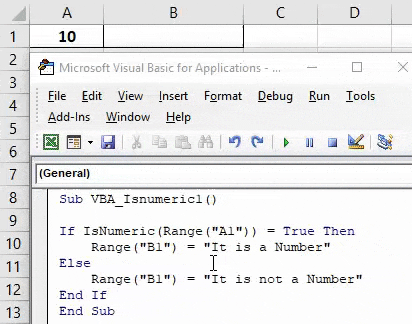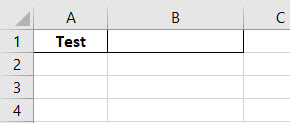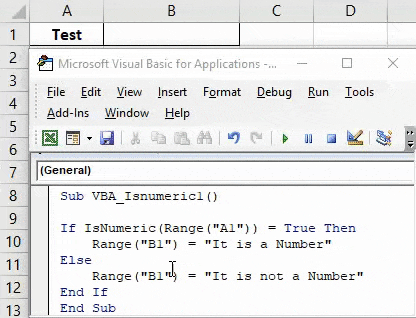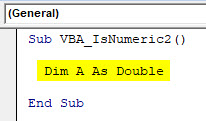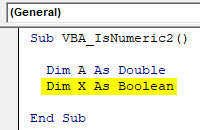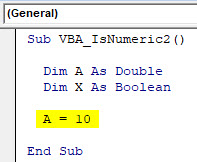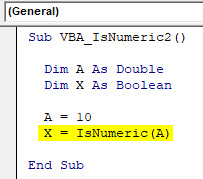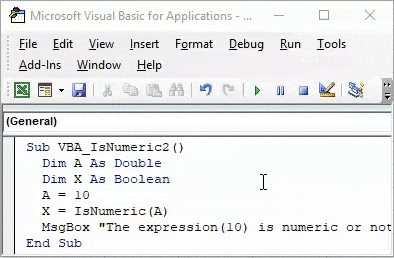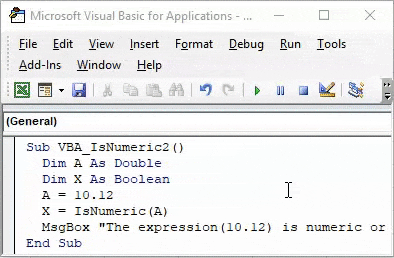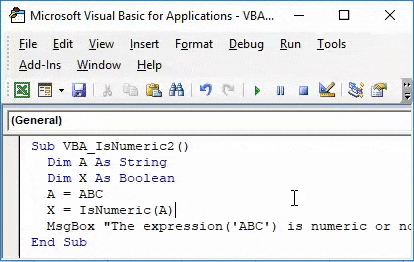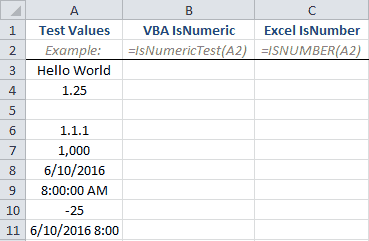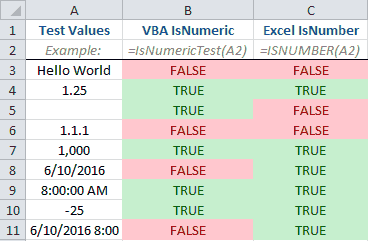Return to VBA Code Examples
This tutorial will teach you how to use the IsNumeric and IsNumber functions in VBA to check if values are numbers.
IsNumeric is a built-in VBA function, while IsNumber is an Excel function which can be called from VBA code.
Difference between IsNumber and IsNumeric in VBA
IsNumber checks if a value is stored as a number. Whereas, IsNumeric checks if a value can be converted into a number.
For example, if you pass a blank cell as a parameter, IsNumber will return FALSE, while IsNumeric will return TRUE. Also, if you pass a cell containing number stored as a text, IsNumber will return FALSE and IsNumeric TRUE.
You need to pay attention to these limitations of both functions and decide in which cases is better to use IsNumeric and when IsNumber.
Using IsNumeric in VBA
IsNumeric is the VBA function which checks if a value is numeric and returns a Boolean TRUE or FALSE as a result.
The function can take a variable or a cell value.
Here is an example of taking a cell value:
If IsNumeric(Sheet1.Range("A1").Value) = True Then
MsgBox "The value in A1 is numeric"
Else
MsgBox "The value in A1 is not numeric"
End IfIn this example, we check if the value from the cell A1 is numeric using the IsNumeric. This function returns the appropriate message, depending on the result of the function.
This next example perform the same operation, except with a variable instead of a cell value:
Dim n as Variant
n = Sheet1.Range("A1").Value
If IsNumeric(n) = True Then
MsgBox "The value in A1 is numeric"
Else
MsgBox "The value in A1 is not numeric"
End IfUsing IsNumber in VBA
IsNumber is an Excel Function, which can be used in VBA. It has an almost similar output as IsNumeric. Let’s look at the example of the IsNumber function:
If Application.WorksheetFunction.IsNumber(Sheet1.Range("A1").Value) = True Then
MsgBox "The value in A1 is numeric"
Else
MsgBox "The value in A1 is not numeric"
End IfAs you can see from the code, the difference is in the syntax when calling the function. Since IsNumber is the Excel function, we need to put Application.WorksheetFunction before the function call.
VBA Coding Made Easy
Stop searching for VBA code online. Learn more about AutoMacro — A VBA Code Builder that allows beginners to code procedures from scratch with minimal coding knowledge and with many time-saving features for all users!
Learn More!
Sub Excel_ISNUMBER_Function()
Dim ws As Worksheet
Set ws = Worksheets(«ISNUMBER»)
ws.Range(«C5») = Application.WorksheetFunction.IsNumber(ws.Range(«B5»))
ws.Range(«C6») = Application.WorksheetFunction.IsNumber(ws.Range(«B6»))
ws.Range(«C7») = Application.WorksheetFunction.IsNumber(ws.Range(«B7»))
ws.Range(«C8») = Application.WorksheetFunction.IsNumber(ws.Range(«B8»))
ws.Range(«C9») = Application.WorksheetFunction.IsNumber(ws.Range(«B9»))
End Sub
OBJECTS
Worksheets: The Worksheets object represents all of the worksheets in a workbook, excluding chart sheets.
Range: The Range object is a representation of a single cell or a range of cells in a worksheet.
PREREQUISITES
Worksheet Name: Have a worksheet named ISNUMBER.
ADJUSTABLE PARAMETERS
Output Range: Select the output range by changing the cell references («C5») through to («C9») in the VBA code to any cell in the worksheet, that doesn’t conflict with the formula.
-
#2
#1
IsNumeric(Cells(1,1))
#2
What do you mean by code? Perhaps
Application.WorkSheetFunction.Code(Range(«A1»))
lenze
Last edited: Jul 22, 2009
-
#3
Hi
1)
Can you be more specific?
Do you mean like the worksheet function IsNumber()?
Questions:
— If the cell has text convertible to a number like the string «123» do you want True or False?
— If the cell has a date, the worksheet function IsNumber() would give you a True. Is this what you want?
2)
I guess you mean the function Asc(). It can also be its big sister AscW() In case of a Unicode character.
-
#4
Thank you for your answers!
pgc01,
— If it’s a date I would like to get FALSE
— If I get a string «123» I would prefer TRUE (but if it’s too complicated, FALSE will do it).
2) by code I mean the worksheet function =Code(), so I’m guessing that your suggestion Asc(Cell(1,1)) will do the job
Thank you guys
-
#5
I have a related question:
1a) I would like to count how many numbers (IsNumeric() will do) different from 0 I have in a given range, say A1:A5.
In the worsheet I would write =SUMPRODUCT(—Isnumber(A1:A5), (A1:A5<>0)).
To find the numbers (even 0), as a first step, I tried
Code:
HowMany = Application.WorksheetFunction.SumProduct(--IsNumeric(rng))but didn’t work
Any suggestions?
Last edited: Jul 22, 2009
-
#6
— If it’s a date I would like to get FALSE
— If I get a string «123» I would prefer TRUE (but if it’s too complicated, FALSE will do it).
Use IsNumeric() as Lenze suggested. It accepts numbers and strings convertible to numbers and refuses dates.
Remark: it also accepts booleans, if you think it’s relevant to your problem test against it.
P. S. Just saw your other post.
Instead of the worksheet function SumProduct() you can use a loop.
Last edited: Jul 22, 2009
-
#7
Thank you!
Managed to create the loop…yay!! (was quite easy though)
Great suggestions guys
ZVI
MrExcel MVP
-
#8
Take into account that string «1D2» is recognized as numeric equal to 1*10^2 = 100.
Therefore IsNumeric(«1D2») = True
To avoid it you can use: IsNumeric(Replace(ActiveCell, «D», «?»)
The code below can help you:
Rich (BB code):
<font face=Courier New>
' Count the numerical values in the Rng range
' VBA usage:
' NumsCount(Range("A1:A5")) <-- Zeroes are not numerical
' NumsCount(Range("A1:A5"), True) <-- Zeroes are numerical
' Formula usage: =NumsCount(A1:A5)
Function NumsCount(Rng As Range, Optional UseZero As Boolean) As Long
Dim arr, v
arr = Rng
If Not IsArray(arr) Then ReDim arr(0): arr(0) = Rng
For Each v In arr
If IsNum(v) Then
If UseZero Then
NumsCount = NumsCount + 1
ElseIf v <> 0 Then
NumsCount = NumsCount + 1
End If
End If
Next
End Function
' The same as IsNumeric() but different for strings like "1D2", and skips the boolean values
' If NumOnly=True then strings are not recognised as numeric at all.
' If UseD=True then strings like "1D2" are recognised as numeric.
Function IsNum(TxtOrNum, Optional NumOnly As Boolean, Optional UseD As Boolean) As Boolean
Select Case VarType(TxtOrNum)
Case 2 To 6, 14
' Any type of numbers
IsNum = True
Case 8
' vbString
If Not NumOnly Then
Dim d As Double
If Not UseD Then
If InStr(UCase(TxtOrNum), "D") > 0 Then Exit Function
End If
On Error Resume Next
d = TxtOrNum
IsNum = Err = 0
End If
End Select
End Function</FONT>
Regards,
Vladimir
Last edited: Jul 22, 2009
-
#9
Hi Vladimir
Good idea, your IsNum().
Maybe you want to deal also with another problem. The vba does not care about commas in expressions when it converts to numbers.
For example if in a cell you have «12,3,45» you would say it’s a list, but vba and your IsNum() will say it’s a valid number. Also for «1,23,4.5,67», if you assign it to a double you get 1234.567, the commas don’t matter to vba, but you would not say that’s a number.
In case of a string maybe the best is to use regular expressions and check the possible formats.
ZVI
MrExcel MVP
-
#10
Hi Vladimir
Good idea, your IsNum().
Maybe you want to deal also with another problem. The vba does not care about commas in expressions when it converts to numbers.
For example if in a cell you have «12,3,45» you would say it’s a list, but vba and your IsNum() will say it’s a valid number. Also for «1,23,4.5,67», if you assign it to a double you get 1234.567, the commas don’t matter to vba, but you would not say that’s a number.
In case of a string maybe the best is to use regular expressions and check the possible formats.
Hi PGC,
May be additional checking of comma in string is enough for solving the list recognising issue:
Rich (BB code):
<font face=Courier New>
' The same as IsNumeric() but different for strings like "1D2", and skips the boolean values
' If NumOnly=True then strings are not recognised as numeric at all.
' If UseD=True then strings like "1D2" are recognised as numeric.
' Comma in string means the list and recognised as not numerical
Function IsNum(TxtOrNum, Optional NumOnly As Boolean, Optional UseD As Boolean) As Boolean
Select Case VarType(TxtOrNum)
Case 2 To 6, 14
' Any type of numbers
IsNum = True
Case 8
' vbString
If Not NumOnly Then
If InStr(TxtOrNum, ",") > 0 Then Exit Function ' <- Comma means the list
Dim d As Double
If Not UseD Then
If InStr(UCase(TxtOrNum), "D") > 0 Then Exit Function
End If
On Error Resume Next
d = TxtOrNum
IsNum = Err = 0
End If
End Select
End Function</FONT>
Regards,
Vladimir
Last edited: Jul 22, 2009
In VBA, to test whether an expression is a number, the IsNumeric function can be used.
Description
The IsNumeric function evaluates whether the input expression is a number and returns a Boolean value (TRUE or FALSE). It returns True if the entire expression is a number; otherwise, it returns False.
Syntax
IsNumeric(expression)
The input expression is either a numeric expression or a string expression.
VBA examples of IsNumeric
Example 1 – Using IsNumeric with IF-THEN-ELSE
The following VBA function CheckNumeic uses IsNumeric to test whether input1 is numeric or not with an IF-THEN-ELSE statement.
Function CheckNumeric(ByVal input1) As String
If IsNumeric(input1) = True Then
MyFunction1 = "Input is numeric"
Else
MyFunction1 = "Input is not numeric"
End If
End Function
I would want to draw your attention to line 2. While this line is correct, it is not necessary. Instead, it can be written as:
If IsNumeric(input1) Then
In VBA, whenever you perform a logical test, for the condition of TRUE, you don’t have to type the =TRUE in the statement.
Example2 – Negate the result of IsNumeric
The VBA function below returns the opposite of IsNumeric. The function uses the same IF-THEN-ELSE structure.
Function IsNumericReverse(ByVal input1) As Boolean
If IsNumeric(input1) = True Then
IsNumericReverse = False
Else
IsNumericReverse = True
End If
End Function
However, this entire structure is not necessary. Instead, the function can be simplified as follows. The Not logical operator can be used to reverse (negate) the answer of IsNumeric, which serves the objective of the function in this case.
Function IsNumericReverse(ByVal input1) As Boolean
IsNumericReverse = Not (IsNumeric(input1))
End Function
Example 3 – VBA action if not numeric
The VBA function counts the number of non-numeric cells in the input range. In line 5, note the use of Not with IsNumeric. In the sentence structure here, putting a space after Not is enough, which is equivalent to using a bracket after Not to wrap the condition being tested.
Function countNonNumeric(range1 As Range) As Long
Dim cell As Range
Dim counter As Long
For Each cell In range1.Cells
If Not IsNumeric(cell.Value) Then 'use Not to test for non-numeric
counter = counter + 1
End If
Next
countNonNumeric = counter
End Function
Special Case with Blank
When using IsNumeric, you need to be aware that “blank” (string of zero length) does not mean zero (0) and it is considered to be non-numeric:
IsNumeric("") returns False
Therefore, when you write your macro, if you want to treat blank as numeric, you may have to use conditional statements to handle the case of blank string inputs.
Special Case with Dates
Another special case with IsNumeric is the treatment of date inputs. Most people conceptually think dates are numeric (after all, they can be converted into date-serials in the computer). However the IsNumeric function in VBA considers dates as non-Numeric:
IsNumeric("10/2/2020") returns False
Even if you try to input a date truly in Date format, IsNumeric still returns False:
IsNumeric(DateSerial(2020, 10, 2)) returns False
Therefore, you may also need to use conditional statements to handle the case of dates expressions.
Special Case with Time
Handling of time expressions by the ISNUMERIC is difficult to manage, or I would describe it as unpredictable. Therefore, when you input expressions contain time expressions, you must test your macro thoroughly.
There are three possibilities with time expressions. Let’s experiment with the macro below. In cell A1, we place a time of “3:00:00 AM” first. Then we run the macro which test 3 cases:
- time in form of string (variable x1)
- time in form of time value (variable x2)
- time placed in a cell in an Excel sheet (variable x3)
Sub TimeCases()
Dim y
x1 = IsNumeric("3:00:00 AM")
x2 = IsNumeric(TimeSerial(3, 0, 0))
y = Range("A1").Value
x3 = IsNumeric(y)
MsgBox x1 &amp;amp;amp;amp; Chr(10) &amp;amp;amp;amp; x2 &amp;amp;amp;amp; Chr(10) &amp;amp;amp;amp; x3
End Sub
Run the macro and the answers will be displayed in the Msgbox:
Calling Excel Worksheet Function ISNUMBER() in VBA
As an alternative to IsNumeric in VBA, you may call the Excel worksheet function ISNUMBER() in your macro. There are two ways to do this. See line 2 and line 3 in the VBA function below, which do the same job. (I personally prefer Method 2.)
Function CallIsNumber(input1) As Boolean x = WorksheetFunction.IsNumber(input1) 'Method 1' x = Application.IsNumber(input1) 'Method 2' CallIsNumber = x End Function
VBA ISNUMERIC vs ISNUMBER Worksheet Function
Although you can either use IsNumeric or Excel worksheet function ISNUMBER to check whether an input expression is numeric, you have to be aware of the differences between the two methods in order to program your macros correctly to produce expected result.
| Expression | Date type of expression | ISNUMERIC returns (VBA) | ISNUMBER returns (worksheet function) |
| 123 | Number | TRUE | TRUE |
| “123” | Number in form of string | TRUE | FALSE |
| 12/2/2020 | Date | FALSE | TRUE |
| “12/2/2020” | Date in form of String | FALSE | FALSE |
| DateSerial(2020,10,2) | Date in form of Date Value | FALSE | FALSE |
| 3:00:00 AM | Time placed in a cell | TRUE | TRUE |
| “3:00:00 AM” | Time in form of String | FALSE | FALSE |
| TimeSerial(3, 0,0) | Time in form of Time Value | FALSE | FALSE |
| “” (blank) | String | FALSE | TRUE |
See also:
- Else if in VBA
VBA IsNumeric
IsNumber an excel function is used for identifying whether the cell content is a number or not. A numeric value can be a whole value or integer. An IsNumeric function can also be performed in VBA as well. In VBA this is available with the name “IsNumeric“. IsNumeric works in the same manner as IsNumber does. It analyzes the cell value and returns the answer whether it is a number or not.
IsNumeric considers only Boolean, which only gives result in the form of TRUE and FALSE.
Syntax of IsNumeric in Excel VBA
VBA IsNumeric has the following syntax in VBA:
How to Use Excel VBA IsNumeric?
We will learn how to use a VBA IsNumeric with few examples in excel.
You can download this VBA IsNumeric Excel Template here – VBA IsNumeric Excel Template
VBA IsNumeric – Example #1
Let’s see an easy example where we will select a cell with any content and in a separate cell, we will see whether cell content is a Number or Not.
Step 1: For this open, a new module in the VBA window under the Insert menu tab as shown below.
Step 2: Write a Subcategory in the name of a performed function or in any other name as shown below.
Code:
Sub VBA_Isnumeric1() End Sub
Step 3: Now we will use the If-Else loop for this complete condition. For this open and close If bracket as shown below.
Code:
Sub VBA_Isnumeric1() If End If End Sub
Step 4: Now in If write and select IsNumeric function and select any Range cell from where we will analyze the content. Here we have selected cell A1 as TRUE.
Code:
Sub VBA_Isnumeric1() If IsNumeric(Range("A1")) = True Then End If End Sub
Step 5: If cell value at cell A1 is TRUE it means it is a number then we can choose writing any sentence in cell B1 which will say “It is a Number” or put any text as per your choice.
Code:
Sub VBA_Isnumeric1() If IsNumeric(Range("A1")) = True Then Range("B1") = "It is a Number" End If End Sub
Step 6: Now in Else line of code consider writing what we could see when IF condition doesn’t work. We are selecting cell B1 where we will see the output statement of cell A1 as “It is not a Number” as shown below.
Code:
Sub VBA_Isnumeric1() If IsNumeric(Range("A1")) = True Then Range("B1") = "It is a Number" Else Range("B1") = "It is not a Number" End If End Sub
Step 7: Once done then compile and run the complete code. As we can see in the below screenshot for the cell content A1 we got the statement as “It is a Number” in cell B1.
Step 8: Now let’s replace 10 in cell A1 with a text like “Test” and see what we get.
Step 9: Now again run the complete code.
As we can see in the above screenshot, for the cell content A1 we got the statement as “It is not a number” for content “Test” which means cell A1 doesn’t have a number in it.
VBA IsNumeric – Example #2
There is another way to add IsNumeric. By far we all know that Boolean function is used for TRUE/ FALSE on the basis of what we feed and define the condition. Here we will use Boolean to calculate IsNumeric for any content of the cell.
Step 1: Write a Subcategory in the name of a performed function as shown below.
Code:
Sub VBA_IsNumeric2() End Sub
Step 2: Now define a dimension “DIM” as A and assign it to Double. We can assign it as Integer or Long too. But that would only consider whole numbers and long text/numbers. Double is used where we are expecting to get numbers in decimal forms.
Code:
Sub VBA_IsNumeric2() Dim A As Double End Sub
Step 3: Now define one more dimension “DIM” as X. And assign it as Boolean. We can consider any word, name or alphabet for defining dimensions in VBA.
Code:
Sub VBA_IsNumeric2() Dim A As Double Dim X As Boolean End Sub
Step 4: Now for Dim A double, first assign the value as 10 which is a whole number.
Code:
Sub VBA_IsNumeric2() Dim A As Double Dim X As Boolean A = 10 End Sub
Step 5: Now for Boolean X, use IsNumeric function and assign defined Double A into the brackets of IsNumeric. By doing this IsNumeric will fetch the value stored in Dim A and analyze whether that value is a number or not.
Code:
Sub VBA_IsNumeric2() Dim A As Double Dim X As Boolean A = 10 X = IsNumeric(A) End Sub
Step 6: To get the answer of an analysis done by Isnumeric, we will assign it to a message box where we will see the result.
Code:
Sub VBA_IsNumeric2() Dim A As Double Dim X As Boolean A = 10 X = IsNumeric(A) MsgBox "The expression(10) is numeric or not : " & X, vbInformation, "VBA IsNumeric Function" End Sub
Step 7: Once done compile and run the code.
As we can see a pop-up dialog box in the above image, the expression(10) is a TRUE numeric value.
Step 8: Now let’s change the value and put some decimal value in IsNumeric as shown below and see what output we get. Here we have to change the value of A as 10.12 and updated the message box with expression(10.12).
Code:
Sub VBA_IsNumeric2() Dim A As Double Dim X As Boolean A = 10.12 X = IsNumeric(A) MsgBox "The expression(10.12) is numeric or not : " & X, vbInformation, "VBA IsNumeric Function" End Sub
Step 9: Now again compile and run the complete code.
We will again get TRUE for the value 10.12 which is a decimal value.
Step 10: Now let’s see if the current defined syntax of IsNumeric still works for other than numbers or not. For this, we need to change the Dim A as String which means we will be entering the Text value here. And change value entered for A. We have considered sample value as “ABC”. Make all necessary changes in related fields where we can place text instead of numbers and keep the rest of the things as it is.
Code:
Sub VBA_IsNumeric2() Dim A As String Dim X As Boolean A = ABC X = IsNumeric(A) MsgBox "The expression('ABC') is numeric or not : " & X, vbInformation, "VBA IsNumeric Function" End Sub
Step 11: After that compile and run the complete code.
Pros of Excel VBA IsNumeric
- It is so easy to apply IsNumeric in VBA. It is as simple as applying Isnumber through insert function.
- IsNumeric and IsNumber give the same result.
Cons of Excel VBA IsNumeric
- Applying example-2 where we need to insert text makes the simple process lengthy.
Things To Remember
- Recording a macro is also a way to perform IsNumeric function in VBA.
- Save the file in Macro-Enabled Excel, This is the best way to avoid losing written code.
- Best way to avoid any error while running the code is to first compile the complete code before we fix it as final.
- Assigning the created code into a button is also a way to perform created macro quickly, this saves time.
- If you are applying IsNumeric by example-2 method then remember to keep text in the single quote (‘Text’) otherwise it will give an error.
- As IsNumeric in VBA is used, in excel it used in the name of IsNumber.
Recommended Articles
This has been a guide to VBA IsNumeric. Here we discussed how to use Excel VBA IsNumeric along with practical examples and downloadable excel template. You can also go through our other suggested articles –
- VBA Dim
- VBA RGB
- VBA IFError
- VBA Login
|
собственно вопрос в названии темы. |
|
|
hk1209 Пользователь Сообщений: 271 |
#2 18.09.2014 16:26:37 можно создать формулу, затем проверить, содержит ли, например, A2, число или текст, =HaveNumbers(A2)
|
||
|
IsNumeric — точно. |
|
|
The_Prist Пользователь Сообщений: 14181 Профессиональная разработка приложений для MS Office |
Только учтите, что вместе с IsNumeric лучше так же использовать Даже самый простой вопрос можно превратить в огромную проблему. Достаточно не уметь формулировать вопросы… |
|
Kuzmich Пользователь Сообщений: 7998 |
Надо еще учесть, что даты тоже числа. |
|
Слава богу, в моем случае этого учитывать не нужно. Извините за ОФФ. я конечно давно зарегистрировался, уже не вспомнить, но… Регистрация: 1 Янв 1970, — я ж тогда ещё и не родился. |
|
|
Dolphin Пользователь Сообщений: 2737 |
#8 18.09.2014 17:16:19
Изменено: Dolphin — 18.09.2014 17:19:59 There is no knowledge that is not power |
||
|
The_Prist Пользователь Сообщений: 14181 Профессиональная разработка приложений для MS Office |
#9 18.09.2014 17:40:34
Если формат ячейки установлен для Дат — то IsNumeric не будет считать дату числом. Это актуально только если формат ячеек общий. Но в этом случае все будет правильно — ведь дата тогда и отображаться будет как число… Даже самый простой вопрос можно превратить в огромную проблему. Достаточно не уметь формулировать вопросы… |
||
|
есть ещё одна ошибка с объединенными ячейками |
|
|
The_Prist Пользователь Сообщений: 14181 Профессиональная разработка приложений для MS Office |
Очень описательно. Даже самый простой вопрос можно превратить в огромную проблему. Достаточно не уметь формулировать вопросы… |
|
Николай Юманов Пользователь Сообщений: 70 |
#12 19.09.2014 14:25:47
Точно! Дело было не в бабине… значение переменной iKol я задал через Inputbox вроде цифры, но в кавычках. <#0> |
||
|
Сливочный Пользователь Сообщений: 178 Win 10, MSO 2016 |
Здравствуйте! Перед занесением диапазона в массив воткнул проверку всех значений диапазона через цикл FOR-NEXT, на отсутствие отрицательных чисел и не чисел, дак вот почему-то при проверке на не числа редактор выделяет isnumeric и останавливается. |
|
Юрий М Модератор Сообщений: 60570 Контакты см. в профиле |
#14 01.08.2016 12:26:08
А путь тут причём? )) Покажите код, лучше вместе с небольшим файлом-примером. |
||
|
Сливочный Пользователь Сообщений: 178 Win 10, MSO 2016 |
Юрий М, прошу прощения, забыл прикрепить файл. Макрос в котором ошибка — myarray а нет не забыл оказывается, что не так? файл-пример уменьшить? Изменено: Сливочный — 01.08.2016 12:33:07 |
|
Юрий М Модератор Сообщений: 60570 Контакты см. в профиле |
А зачем там Is Nothing? Удалите это. |
|
Сливочный Пользователь Сообщений: 178 Win 10, MSO 2016 |
Юрий М, надо проверить, если проверяемое значение не число или число но меньше 0, выйти из макроса. |
|
Юрий М Модератор Сообщений: 60570 Контакты см. в профиле |
#18 01.08.2016 12:46:06 Я же говорил — Nothig уберите:
|
||
|
Сливочный Пользователь Сообщений: 178 Win 10, MSO 2016 |
#19 01.08.2016 12:55:53 Юрий М, всё работает, спасибо! |
Содержание
- Метод WorksheetFunction.IsNumber (Excel)
- Синтаксис
- Параметры
- Возвращаемое значение
- Примечания
- Поддержка и обратная связь
- Метод WorksheetFunction.IsNumber (Excel)
- Синтаксис
- Параметры
- Возвращаемое значение
- Примечания
- Поддержка и обратная связь
- IsNumeric VBA Function Checks if Cell is a Number
- The VBA Tutorials Blog
- Introduction to IsNumeric
- IsNumeric Examples
- Check if a Cell is a Number
- Check if All Cells in a Range are Numeric
- IsNumeric vs ISNUMBER
- Final Thoughts
- Функция IsNumeric
- Примеры запросов
- Пример VBA
- Using Isnumeric and Isnumber in VBA
- Difference between IsNumber and IsNumeric in VBA
- Using IsNumeric in VBA
- Using IsNumber in VBA
- VBA Coding Made Easy
- VBA Code Examples Add-in
Метод WorksheetFunction.IsNumber (Excel)
Проверяет тип значения и возвращает значение True или False в зависимости от того, ссылается ли значение на число.
Синтаксис
expression. IsNumber (Arg1)
Выражение Переменная, представляющая объект WorksheetFunction .
Параметры
| Имя | Обязательный или необязательный | Тип данных | Описание |
|---|---|---|---|
| Arg1 | Обязательный | Variant | Value — значение, которое требуется протестировать. Значение может быть пустым (пустая ячейка), ошибкой, логическим, текстовым, числом или ссылочным значением или именем, ссылающимся на любое из этих значений, которое требуется проверить. |
Возвращаемое значение
Boolean
Примечания
Аргументы значений функций IS не преобразуются. Например, в большинстве других функций, где требуется число, текстовое значение 19 преобразуется в число 19. Однако в формуле ISNUMBER(«19») значение 19 не преобразуется из текстового значения, и функция IsNumber возвращает значение False.
Функции IS полезны в формулах для проверки результата вычисления. В сочетании с функцией IF они предоставляют метод для обнаружения ошибок в формулах.
Поддержка и обратная связь
Есть вопросы или отзывы, касающиеся Office VBA или этой статьи? Руководство по другим способам получения поддержки и отправки отзывов см. в статье Поддержка Office VBA и обратная связь.
Источник
Метод WorksheetFunction.IsNumber (Excel)
Проверяет тип значения и возвращает значение True или False в зависимости от того, ссылается ли значение на число.
Синтаксис
expression. IsNumber (Arg1)
Выражение Переменная, представляющая объект WorksheetFunction .
Параметры
| Имя | Обязательный или необязательный | Тип данных | Описание |
|---|---|---|---|
| Arg1 | Обязательный | Variant | Value — значение, которое требуется протестировать. Значение может быть пустым (пустая ячейка), ошибкой, логическим, текстовым, числом или ссылочным значением или именем, ссылающимся на любое из этих значений, которое требуется проверить. |
Возвращаемое значение
Boolean
Примечания
Аргументы значений функций IS не преобразуются. Например, в большинстве других функций, где требуется число, текстовое значение 19 преобразуется в число 19. Однако в формуле ISNUMBER(«19») значение 19 не преобразуется из текстового значения, и функция IsNumber возвращает значение False.
Функции IS полезны в формулах для проверки результата вычисления. В сочетании с функцией IF они предоставляют метод для обнаружения ошибок в формулах.
Поддержка и обратная связь
Есть вопросы или отзывы, касающиеся Office VBA или этой статьи? Руководство по другим способам получения поддержки и отправки отзывов см. в статье Поддержка Office VBA и обратная связь.
Источник
IsNumeric VBA Function Checks if Cell is a Number
The VBA Tutorials Blog
Introduction to IsNumeric
The IsNumeric VBA function checks if a cell is a number and expresses the answer as a Logical Boolean ( True or False ). The IsNumeric VBA function is a counterpart to the Excel ISNUMBER function, but the expressions don’t always produce the same results.
This isn’t the first time you’ve seen me use IsNumeric in my VBA macros, but in this tutorial I’ll explain how it’s used and what it’s good for. Let’s get started.
- If IsNumeric thinks your expression is a number, it will return a value of True.
- If it’s not a number, it will return False.
The syntax for the IsNumeric function can’t get any simpler:
As you can see, IsNumeric accepts one argument: an expression of the Variant Data Type. I know, I know. The complicated jargon isn’t necessary.
All you need to know is that IsNumeric can pretty much evaluate anything. A cell, a string, a date, a range. It won’t choke up on any of these, but that doesn’t mean it’ll give you the answer you want.
For example, if you enter a range, like Range(«A1:B5») , into an IsNumeric expression, it will always return False even if all the values in the range ARE numeric. The IsNumeric function won’t loop through each cell in your range and check whether each of them are numeric. You’ll have to do that with a loop of your own, like a For Each loop. I’ll show you a macro that does that in the IsNumeric Examples section.
Because IsNumeric returns True or False, it’s a great expression to include inside If Statements. Let’s take a look at a couple examples.
IsNumeric Examples
Check if a Cell is a Number
Make powerful macros with our free VBA Developer Kit
It’s easy to copy and paste a macro like this, but it’s harder make one on your own. To help you make macros like this, we built a free VBA Developer Kit and wrote the Big Book of Excel VBA Macros full of hundreds of pre-built macros to help you master file I/O, arrays, strings and more — grab your free copy below.
This example macro tests if the value in cell A1 is a number. If it is, the value in cell B1 says it’s a number. Otherwise, it says it’s not a number.
You don’t need to put the = True in the above If Statement, but I included it to make the macro easier to read.
If you have a macro that performs arithmetic expressions, it’s a good practice to use IsNumeric to make sure your input is numeric before performing the math. As a side note, it’s also a good to make sure your input isn’t empty by using the IsEmpty function. That’s another tutorial for another day.
Check if All Cells in a Range are Numeric
The above macro checks each cell in your range and the moment it finds one that isn’t numeric, it exits the For Each loop and lets you know there are non-numeric cells in the range.
As a programmer, you can perform different actions based on whether the entire range is numeric or not. Checks like this one give you more control over how you handle errors.
IsNumeric vs ISNUMBER
To test how the IsNumeric VBA and the ISNUMBER Excel functions behave, we’re going to make a User Defined Function (UDF) to evaluate the following cells in Column A:
We’ll use the native ISNUMBER function of Excel in Column C and we’ll use the the following UDF to represent our VBA IsNumeric function in Column B.
We’ll evalulate the expressions in Column A using both the VBA IsNumeric() function (Column B) and the Excel =ISNUMBER() function (Column C). You would expect them to be identical, right? You’re about to be surprised…
The two functions yield completely different answers when evaluating the same data. IT’S CRAZY!
By looking at the comparison image, you can see the VBA IsNumeric function considers empty cells numeric, but the Excel ISNUMBER function does not. That’s why I said earlier that it’s a good VBA practice to check if your cell is empty by using the IsEmpty function when you use the IsNumeric function.
Another difference you can see is in how the two functions treat dates and times. IsNumeric VBA says times are numbers, but dates are not. It also says the combination of dates and times are not numeric. ISNUMBER, on the other hand, says all 3 date/time cells are numeric.
Final Thoughts
Congratulations! You’re now an IsNumeric expert! You certainly know more about IsNumeric than the average Excel user, and for that you should be excited.
IsNumeric is a great VBA function, but, as you’ve seen, you have to be careful when using it if there’s a chance your input may be blank or if you’re evaluating dates and times.
It’s important to know what a function does well, but it’s equally important to know what a function doesn’t do well. I hope you find this VBA tutorial informative and you’re IsNumeric in your own macros!
For more VBA tips, techniques, and tactics, subscribe to our VBA Insiders email series using the form below. After you subscribe, share what you’re automating on Twitter and Facebook.
Ready to do more with VBA?
We put together a giant PDF with over 300 pre-built macros and we want you to have it for free. Enter your email address below and we’ll send you a copy along with our VBA Developer Kit, loaded with VBA tips, tricks and shortcuts.
Before we go, I want to let you know we designed a suite of VBA Cheat Sheets to make it easier for you to write better macros. We included over 200 tips and 140 macro examples so they have everything you need to know to become a better VBA programmer.
Источник
Функция IsNumeric
Возвращает boolean value, указывающее, выражение можно высмеять как число.
Обязательный аргумент выражениеаргумент является значением типа Variant, содержащим числовое выражение или строковое выражение.
IsNumeric возвращает true, если выражение целиком распознается как число; в противном случае возвращается false.
IsNumeric возвращает false, если выражение является выражение даты.
Примеры запросов
SELECT IsNumeric([UnitPrice]) AS Expr1 FROM ProductSales;
Функция оценивает, является ли значение «UnitPrice» допустимым числом, и возвращает результат «-1» для значения «Истина» и «0» для значения «Ложь» в столбце «Вырасть1». Результат — -1 (Истина).
SELECT IsNumeric([DateofSale]) AS ValidNumber, IsNumeric(«487.34») AS NumberTest FROM ProductSales;
Функция оценивает, является ли «DateofSale» и «487,34» допустимым числом, и возвращает результат «-1» для «Истина» и «0» для ложь в столбцах ValidNumber и NumberTest соответственно. Результат составляет 0 (Ложь) для validNumber и -1(True) для NumberTest.
Пример VBA
Примечание: В примерах ниже показано, как использовать эту функцию в модуле Visual Basic для приложений (VBA). Чтобы получить дополнительные сведения о работе с VBA, выберите Справочник разработчика в раскрывающемся списке рядом с полем Поиск и введите одно или несколько слов в поле поиска.
В этом примере функция IsNumeric используется для определения того, может ли переменная быть оценена как число.
Источник
Using Isnumeric and Isnumber in VBA
In this Article
This tutorial will teach you how to use the IsNumeric and IsNumber functions in VBA to check if values are numbers.
IsNumeric is a built-in VBA function, while IsNumber is an Excel function which can be called from VBA code.
Difference between IsNumber and IsNumeric in VBA
IsNumber checks if a value is stored as a number. Whereas, IsNumeric checks if a value can be converted into a number.
For example, if you pass a blank cell as a parameter, IsNumber will return FALSE, while IsNumeric will return TRUE. Also, if you pass a cell containing number stored as a text, IsNumber will return FALSE and IsNumeric TRUE.
You need to pay attention to these limitations of both functions and decide in which cases is better to use IsNumeric and when IsNumber.
Using IsNumeric in VBA
IsNumeric is the VBA function which checks if a value is numeric and returns a Boolean TRUE or FALSE as a result.
The function can take a variable or a cell value.
Here is an example of taking a cell value:
In this example, we check if the value from the cell A1 is numeric using the IsNumeric. This function returns the appropriate message, depending on the result of the function.
This next example perform the same operation, except with a variable instead of a cell value:
Using IsNumber in VBA
IsNumber is an Excel Function, which can be used in VBA. It has an almost similar output as IsNumeric. Let’s look at the example of the IsNumber function:
As you can see from the code, the difference is in the syntax when calling the function. Since IsNumber is the Excel function, we need to put Application.WorksheetFunction before the function call.
VBA Coding Made Easy
Stop searching for VBA code online. Learn more about AutoMacro — A VBA Code Builder that allows beginners to code procedures from scratch with minimal coding knowledge and with many time-saving features for all users! 
VBA Code Examples Add-in
Easily access all of the code examples found on our site.
Simply navigate to the menu, click, and the code will be inserted directly into your module. .xlam add-in.
Источник
Home / VBA / Top VBA Functions / VBA ISNUMERIC Function (Syntax + Example)
The VBA ISNUMERIC function is listed under the information category of VBA functions. When you use it in a VBA code, it evaluates the supplied expression and returns TRUE if it is a numeric value or else FALSE. In simple words, it can check whether the value supplied is a number or not and returns TRUE or FALSE based on that.
IsNumeric(Expression)
Arguments
- Expression: An expression that you want to test if it’s numeric or not.
Example

To practically understand how to use the VBA ISNUMERIC function, you need to go through the below example where we have written a vba code by using it:
Sub example_ISNUMERIC()
Range("B1").Value = IsNumeric(Range("A1"))
End SubIn the above code, we have used ISNUMERIC to check it the value in cell A1 is a number or not and it has returned TRUE in the result as we have 98 in cell A1.



